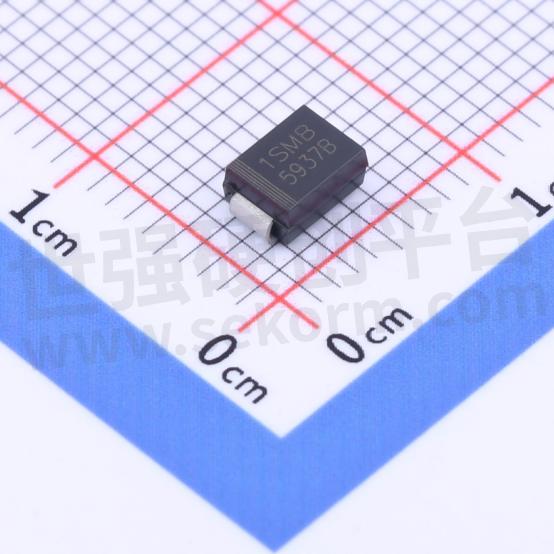1SMB5937B: High-Power Voltage Regulation Solution with 33V Nominal Voltage Regulation Value, 3W Power Handling Capacity and Extremely Low Reverse Current

In the design of electronic devices, Voltage Regulator Diodes play a crucial role. They provide stable voltage output in circuits, ensuring the normal operation of devices under various working conditions. Among numerous voltage regulator diodes, the 1SMB5937B stands out as an ideal choice for high-power voltage regulation solutions due to its unique performance parameters such as a 33V nominal voltage regulation value, 3W power handling capacity, and extremely low reverse current.

SLKOR Voltage Regulator Diode 1SMB5937B product photo
Basic Parameters of 1SMB5937B
The 1SMB5937B voltage regulator diode features a nominal voltage regulation value of 33V, meaning it can provide a stable 33V voltage output in circuits. Additionally, the diode has a power handling capacity of 3W, allowing it to meet the demands of higher-power circuits. Furthermore, its reverse current is only 1μA at 25.1V, indicating extremely low power consumption under normal operating conditions, thereby reducing overall device energy consumption.
Advantages of 1SMB5937B
High Power Handling Capacity: With a 3W power handling capacity, the 1SMB5937B can accommodate a broader range of current requirements, ensuring circuit stability and reliability.
Low Reverse Current: Its reverse current is only 1μA at 25.1V, helping to reduce overall device energy consumption and heat generation, thereby improving device performance and longevity.
Stable Voltage Output: The 1SMB5937B features a nominal voltage regulation value of 33V, providing a stable voltage output in circuits, ensuring the normal operation of devices under various working conditions.
The Reverse Connection Modes of Voltage Regulator Diodes in Circuits: Load Regulation and Power Supply Regulation
In electronic circuit design, voltage regulator diodes are indispensable components that provide stable voltage output in circuits, ensuring normal operation under various working conditions. The reverse connection modes of voltage regulator diodes are particularly important in circuit design, mainly divided into load regulation and power supply regulation.
Load Regulation
Load regulation is a common reverse connection mode of voltage regulator diodes, mainly used to protect load circuits from voltage fluctuations. In this connection mode, the negative terminal (cathode) of the voltage regulator diode is connected to the positive terminal of the load circuit, while the positive terminal (anode) is connected to the negative terminal or ground of the load circuit.
When the power supply voltage increases, the voltage at both ends of the load circuit also increases accordingly. Once this voltage exceeds the regulation value of the voltage regulator diode, the diode enters the breakdown state and starts to conduct. At this point, the voltage regulator diode absorbs the excess voltage and converts it into heat, thereby maintaining the voltage at both ends of the load circuit stable. In this way, load regulation can effectively protect the load circuit from damage caused by excessive voltage.
Power Supply Regulation
Power supply regulation is another reverse connection mode of voltage regulator diodes, mainly used to stabilize the output voltage of the power supply. In this connection mode, the negative terminal (cathode) of the voltage regulator diode is connected to the positive terminal of the power supply, while the positive terminal (anode) is connected to the negative terminal or ground of the power supply.
When the power supply voltage fluctuates, the voltage regulator diode responds quickly and adjusts its conduction state to maintain the stability of the power supply output voltage. When the power supply voltage increases, the voltage regulator diode enters the breakdown state, starts to conduct, and absorbs the excess voltage; when the power supply voltage decreases, the voltage regulator diode reduces its conduction level, reducing the voltage drop. In this way, power supply regulation can effectively stabilize the output voltage of the power supply, ensuring stable power supply for the circuit under various working conditions.
Comparison and Selection of Two Modes
Load regulation and power supply regulation have their own characteristics, and the choice depends on specific requirements in practical applications.
Load regulation mainly focuses on protecting load circuits and is suitable for occasions where the stability of load circuit voltage is required. It can effectively prevent damage to the load circuit caused by excessive voltage, improving the reliability and safety of the circuit. However, load regulation cannot directly control the output voltage of the power supply, only passively protecting the load circuit.
Power supply regulation pays more attention to the stability of power supply output voltage and is suitable for occasions where higher requirements are placed on the output voltage of the power supply. It can stabilize the power supply output voltage by actively adjusting the conduction state of the voltage regulator diode, ensuring stable power supply for the circuit under various working conditions. However, power supply regulation requires additional circuit design and debugging, with relatively higher costs.
- +1 Like
- Add to Favorites
Recommend
- 1SMB5934B Voltage Regulator Diode Features High Precision, Reliability and Power-handling Capabilities
- The Voltage Regulator Diode 1SMB5925B, A Indispensable Component in Modern Electronic Systems
- The Voltage Regulator Diode 1SMB5923B Has Several Applications in Bluetooth Earphone Battery Circuits
- The Voltage Regulator Diode 1SMB5935B Features A Maximum Power Dissipation of 3W and A Stable Voltage Value of 27V
- How is the Delivery Efficiency of SLKOR?
- Slkor Participated in the 8th Qianren Summit of Dajia Yuan
- Has SLKOR Passed ISO14001?
- Song Shiqiang from SLKOR Keynote Speech -How AI Empowers New Quality Productive Forces
This document is provided by Sekorm Platform for VIP exclusive service. The copyright is owned by Sekorm. Without authorization, any medias, websites or individual are not allowed to reprint. When authorizing the reprint, the link of www.sekorm.com must be indicated.





























































































































































































































































































































































































































































































































































































































































































































































































































































































